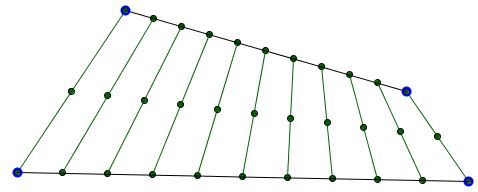Hjelmslev's Theorem:
What is this about?
A Mathematical Droodle
(The black segments in the applet can be dragged by their end points or by any interior point.)
|Activities| |Contact| |Front page| |Contents| |Geometry|
Copyright © 1996-2018 Alexander BogomolnyThe applet illustrates what's known as Hjelmslev's theorem, named after the notable Danish mathematician Johannes Hjelmslev (1873-1950):
If two line segments $I_{1}$ and $I_{2}$ are related by an isometry $f: P_{1} \rightarrow P_{2},$ then the midpoints between the corresponding points $P_{1},$ $P_{2}$ are either all different and collinear or all coincide.

The applet in fact shows more: the relation between the two segments need not be isometric, it may be just affine. Also, it is not necessary to consider the midpoints of $P_{1}P_{2}.$ All the points that are determined by the same linear combination of the corresponding points are either different and collinear or all coincide.
Points in a segment $AB$ are parametrized by a linear expression:
$P = P(t) = tA + (1 - t)B,$
where $0 \le t \le 1.$ If $A$ and $B$ are different, $P(t)$ is 1-1, for
$\begin{align} P(t) - P(s) &= (t - s)A + (s - t)B\\ &= (t - s)(A - B). \end{align}$
Thus $P(s) = P(t)$ implies either $t = s$ or $A = B.$
A mapping $f$ defined on such a segment $AB$ is affine provided
$f(tA + (1 - t)B) = tf(A) + (1 - t)f(B).$
For two segments $A_{1}B_{1},$ $A_{2}B_{2},$ an affine mapping $f$ is defined by
$f(P_{1}) = f(tA_{1} + (1 - t)B_{1}) = tA_{2} + (1 - t)B_{2} = P_{2}.$
For a fixed $r,$ $0 \le r \le 1,$ point $P = rP_{1} + (1 - r)P_{2}$ lies on the segment $P_{1}P_{2}.$ Further,
(1)
$\begin{align} P &= rP_{1} + (1 - r)P_{2}\\ &= r[tA_{1} + (1 - t)B_{1}] + (1 - r)[tA_{2} + (1 - t)B_{2}]\\ &= t[rA_{1} + (1 - r)A_{2}] + (1 - t)[rB_{1} + (1 - r)B_{2}]\\ &= tA_{r} + (1 - t)B_{r} \end{align}$
and therefore belongs to the segment joining
$A_{r} = rA_{1} + (1 - r)A_{2}$
with
$B_{r} = rB_{1} + (1 - r)B_{2},$
provided of course the two are different. If they are not, all the linear combinations in (1) coincide. For $r = 1/2,$ we obtain the Hjelmslev's Theorem.
(A JavaScript illustration is available elsewhere.)
References
- H. S. M. Coxeter, Introduction to Geometry, John Wiley & Sons, 1961
|Activities| |Contact| |Front page| |Contents| |Geometry|
Copyright © 1996-2018 Alexander Bogomolny73574265
